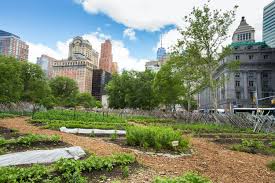
Sometimes, it may look a bit weedy or unkempt, but that's a part of the plan. Insects and birds are not interested in neat, uniform rows of popcorn shrubs and ornamental flowers. Instead, they're looking for food, shelter, and a place to nest. For that, cities need a diverse selection of native flora and lots of trees to meet the needs of the various pollinators.
In Bexley, Ohio, some creative genius devised a way for the entire city to transform their underutilized alleys into spaces everyone could enjoy by planting native plants, installing benches, and designing artwork to create their own Homegrown National Park. The Love Your Alley program focused on community collaboration, sustainability, creativity, and beauty.
Rebecca Ness spearheaded the initiative and says they distributed 850 plants to 25 different volunteer teams comprised of seasoned and first-time gardeners aged from school kids to senior citizens.
Each alleyway presented a unique challenge. "Some people had four feet deep by 25 feet wide to work with, and other people had six inches of space along a fence," Rebecca explained. "They had to design it according to the space and the available sunlight, so it was a challenge each group had to solve as a team." It proved to be a great success.
It's Up to You and Me
Locating untouched natural green zones in urban areas can be difficult. Cities are growing, and there are no signs of the growth slacking off. By 2050, it's estimated that two-thirds of the world's population will live in urban areas.
As municipalities continue to spread across the planet, isolated patches and fragments of wilderness are all that's left. The gardens we plant must serve as living space for native plants, insects, birds, and animals.
Researchers are finding that the flowers, shrubs, and trees planted in parks, residential properties, community vegetable plots, and city lots surprisingly support many healthy populations of wild bees. In a few cases, urban bee populations are more diverse and abundant than their country cousins.
Now is an excellent time to plan for next spring. It's still safe to plant native trees or shrubs if you live in an area where the soil temperature is consistently 50 degrees or higher. Check with your local native plant society to find out what plants are best suited for autumn/winter planting. Plus, winter sowing is a proven method of germinating seeds no matter where you live. Winter sowing gives you a head start on your spring planting by having healthy, hardy native flowers ready to stick in the ground after the last frost.
So, let's show our support for our pollinating superheroes who do so much for us. Plant a few native flowers or a tree or two or ten. You know all this greenery not only benefits the birds and the bugs, it also makes life a lot better for us, too.
Green Spaces Benefit the Community
Trees are Mother Nature's air purifiers and central air conditioning units. They reduce air pollution, offset carbon emissions, and cool off the "heat island effect" caused by miles of pavement and concrete trapping in the warm air.
Having pollinator-friendly landscapes with many trees, shrubs, and plants makes an urban area look welcoming to two-legged, four-legged, and winged guests. Taking a stroll through a park revitalizes your mind as well as your body. Stretching your legs and exercising helps get the mental and physical juices flowing, using muscles that don't get much activity while sitting and idling at the computer. Your body and brain appreciate the new sights and sounds and just chilling out for a while, destressing, and relaxing.
There are no side effects attributed to green spaces, no harmful fumes, or any need for fancy equipment. All it requires is a little time and effort to plant it and a whole lot of time enjoying it.
 RSS Feed
RSS Feed

